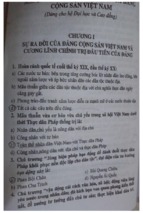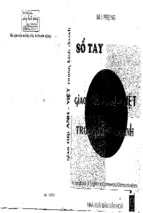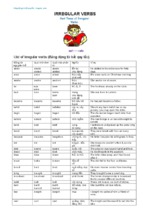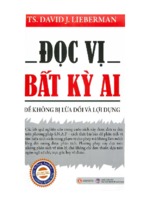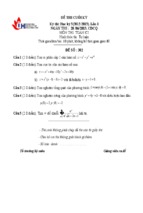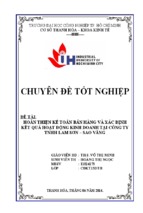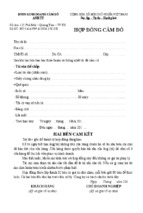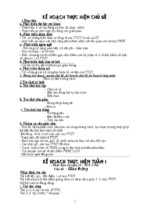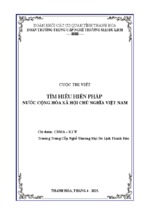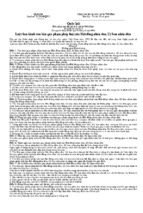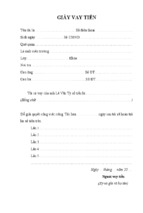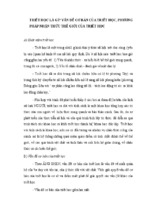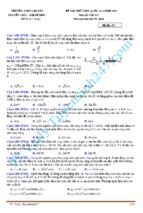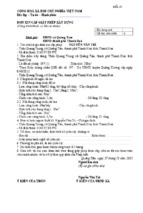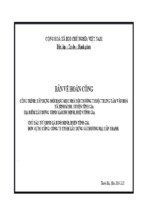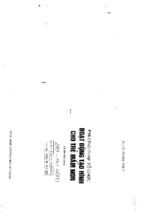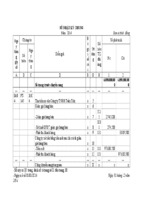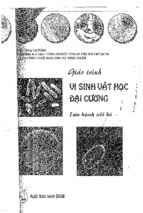HANOI OPEN UNIVERSITY
HISTORY OF THE ENGLISH LANGUAGE
AND GLOBLE ENGLISH
(for Internal Use)
Lưu Chí Hải
Nguyễn Thị Vân Đông
HANOI – 2019
CONTENTS
INTRODUCTION ............................................................................................................ 7
UNIT ONE: A BRIEF HISTORY OF ENGLISH WITH CHRONOLOGY AND OLD
ENGLISH ......................................................................................................................... 9
1. The old English period (449-1100) .............................................................................. 9
2. Sone key events in the old English period ................................................................... 9
3. Britain before the English ........................................................................................... 10
4. The coming of the English ......................................................................................... 11
5. The English in Britain ................................................................................................ 13
6. The first Viking conquest .......................................................................................... 14
7. The second Viking conquest ..................................................................................... 16
8. The Scandinavians become English .......................................................................... 17
9. The golden age of old English ................................................................................... 17
10. Dialects of old English ............................................................................................ 18
11. Old English phonology ............................................................................................ 18
12. Morphology ............................................................................................................. 22
13. Syntax ...................................................................................................................... 23
EXERCISES .................................................................................................................. 24
UNIT TWO: MIDDLE ENGLISH ................................................................................ 26
1. Introduction ..................................................................................................................
2. Middle English Creole hypothesis................................................................................ .
3. Decay of inflectional endings .................................................................................... 27
4. The noun ....................................................................................................................... .
5. The adjective.............................................................................................................. 29
6. The pronoun ............................................................................................................... 30
7. The verb ..................................................................................................................... 31
8. French influence on the vocabulary .......................................................................... 33
EXERCISES .................................................................................................................. 35
UNIT THREE: MODERN ENGLISH .......................................................................... 38
1. Definition ................................................................................................................... 38
2. Development .............................................................................................................. 39
3. Outline of changes ..................................................................................................... 41
EXERCISES .................................................................................................................. 43
1
UNIT FOUR: LIST DIALECTS OF THE ENGLISH LANGUAGE AND
STANDARD ENGLISH ............................................................................................... 46
1. Introduction ............................................................................................................... 47
2. By continent ............................................................................................................... 47
3. Creoles ....................................................................................................................... 53
4. Constructed: ............................................................................................................... 53
5. Manual encodings: ..................................................................................................... 56
6. Code-switching: ......................................................................................................... 56
7. Standard English. ....................................................................................................... 57
EXERCISES .................................................................................................................. 58
UNIT 5: INTERNATIONAL ENGLISH ..................................................................... 61
1. Historical context ....................................................................................................... 61
2. English as a global language ..................................................................................... 64
3. English as a lingua franca in foreign language teaching ........................................... 65
4. Varying concepts: ...................................................................................................... 67
EXERCISES .................................................................................................................. 70
UNIT SIX: ENGLISH IN ENGLAND ......................................................................... 70
1. General features ......................................................................................................... 73
2. Change over time ....................................................................................................... 76
3. Overview of regional accents .................................................................................... 77
4. Southern England ...................................................................................................... 78
5. South West England .................................................................................................. 79
6. East Anglia ................................................................................................................ 80
7. Midlands .................................................................................................................... 80
8. Northern England ...................................................................................................... 82
9. Examples of accents used by public figures: ............................................................. 85
10. Regional English accents in the media: ................................................................... 88
EXERCISES .................................................................................................................. 89
UNIT SEVEN: AMERICAN ENGLISH AND DIFFERENCES BETWEEN BRITISH
AND AMERICAN ENGLISH ..................................................................................... 91
1. Introduction of American English ............................................................................. 91
2. Definition of American English ................................................................................ 91
3. Historical background ............................................................................................... 91
4. Regional variation ..................................................................................................... 93
5. American and British English differences ................................................................. 96
2
EXERCISES ................................................................................................................ 101
UNIT EIGHT: AUSTRALIAN ENGLISH ................................................................. 104
1. History ..................................................................................................................... 104
2. Phonology and pronunciation .................................................................................. 106
3. Variation: ................................................................................................................. 109
4. Vocabulary............................................................................................................... 110
5. Grammar: ................................................................................................................. 115
6. Spelling and style .................................................................................................... 116
EXERCISES ................................................................................................................ 117
UNIT NINE: CANADIAN ENGLISH ....................................................................... 120
1. Introduction ............................................................................................................. 120
2. History ..................................................................................................................... 120
3. Historical linguistics ................................................................................................ 121
4. Spelling tendencies .................................................................................................. 122
5. Dictionaries .............................................................................................................. 124
6. Phonology and phonetics ......................................................................................... 125
7. Grammar .................................................................................................................. 132
Date and time notation ................................................................................................. 132
8. Vocabulary............................................................................................................... 132
9. Attitudes towards Canadian English ....................................................................... 142
EXERCISES ................................................................................................................ 143
UNIT TEN: ENGLISH PRESENT AND FUTURE ................................................... 144
1. The History of the English Language as a Cultural Subject. .................................. 144
2. Influences at Work on Language. ............................................................................ 145
3. Growth and Decay ................................................................................................... 146
4. The Importance of a Language ................................................................................ 146
5. The Importance of English ...................................................................................... 147
6. The Future of the English Language ....................................................................... 148
7. English as a World Language .................................................................................. 151
8. Assets and Liabilities ............................................................................................... 153
9. Cosmopolitan Vocabulary ....................................................................................... 154
10. Liabilities ............................................................................................................... 155
EXERCISES ................................................................................................................ 157
References ................................................................................................................... 159
3
4
INTRODUCTION
This book is designed for the major students at the Faculty of English, Hanoi Open
University. The book ‘History of the English Language’ is a comprehensive
exploration of the linguistic and cultural development of English, from the OLd Ages
to present day. The book provides students with a balanced and up-to-date overview of
the history of the English language and the trend of English in the future. It also
provides students with varieties of English, the linguistic change, the influences of
others languages on English, the notion of dialect and variation across geographical
and social boundaries, the ways in which words change meanings and the ways
English borrows new words… . It is also a process of concerning English as an official
language and the status of a standard English.
The book includes 10 units. In unit one, we focus on the brief history of English
with chronology and Old English. We begin with the study of why English we use
today. We also describe the spread of English in its empire. Unit two and three focus
on the development of Middle and Modern English and foreign influences on those
English, the role of English and distinguish the differences between the Old English,
Middle English, Modern English. In unit four, we provide list of dialects of the
English language in the world and some concepts of standard English. The concepts of
international English are introduced in unit five as well as its historical context of
developing it. Unit six and seven focus on the dialects of English in England and
America and some differences between them. The lectures explore the rise of
American dialects, differences between American and British pronunciation and
usage, and the emergence of distinctive American voices in literature, social criticism,
and politics. Unit 8 discusses about typical characteristics of English in Australia.
Canadian English is mentioned in the unit 9. In this unit the historical context and the
varieties of English in Canada are the information that we would like to introduce. The
English present and future is the last unit. In this unit, we would like to inform the
importance of the English language and the possible future of English in world.
5
UNIT ONE: A BRIEF HISTORY OF ENGLISH
WITH CHRONOLOGY AND OLD ENGLISH
Objectives: Upon completion of this lecture, you should be able to:
1. Define just what OE is and when and where it was spoken.
2. Identify the major regional dialects and historical periods of OE.
3. Describe the major features of OE.
4. Recognize why the English appeared in England.
5. Describe some characteristics of old English.
1. The old English period (449-1100)
The history of English language is a long period and very complication. This
parallels the history and socio-culture of England. The recorded history of the
English language begins, not on the Continent, where we know its speakers once
lived, but in the British Isles, where they eventually settled. During the period
when the language was spoken in Europe, it is known as pre-old English, for it
was only after the English separated themselves from their Germanic cousins
that recognize their speech as a distinct language and begin to have records of it.
Periodization:
- Pre - historical/pre - Roman
- Old English (450 - 110 AD)
- Middle English (110 - 1500)
- Modern English (1500 - present)
2. Some key events in the old English period
The following events during the Old English period significantly influenced
the development of the English language.
449 Angles, Saxons, Jutes, and Frisians began to occupy Great Britain, thus
changing its major population to English speakers and separating the early
English language from its Continental relatives. This is a traditional date; the
actual migrations doubtless began earlier.
6
597 Saint Augustine of Canterbury arrived in England to begin the conversion of the English by baptizing King Ethelbert of Kent, thus introducing the
influence of the Latin language.
664 The Synod of Whitby aligned the English with Roman rather than Celtic
Christianity, thus linking English culture with mainstream Europe.
730 The Venerable Bede produced his Ecclesiastical History of the English
People, recording the early history of the English people.
787 The Scandinavian invasion began with raids along the northeast
seacoast.
865 The Scandinavians occupied northeastern Britain and began a campaign
to conquer all of England.
871 Alfred became king of Wessex and reigned until his death in 899, rallying the English against the Scandinavians, retaking the city of London, establishing the Danelaw, securing the kingship of all England for himself and his
successors, and producing or sponsoring the translation of Latin works into
English.
987 Elfric, the homilist and grammarian, went to the abbey of Cerne, where
he became the major prose writer of the Old English period and of its
Benedictine Revival and produced a model of prose style that influenced
following centuries.
991 Olaf Tryggvason invaded England, and the English were defeated at the
Battle of Maldon.
1000 The manuscript of the Old English epic Beowulf was written about this
time.
1016 Canute became king of England, establishing a Danish dynasty in
Britain.
1042 The Danish dynasty ended with the death of King Hardicanute, and
Edward the Confessor became king of England.
1066 Edward the Confessor died and was succeeded by Harold, last of the
Anglo-Saxon kings, who died at the Battle of Hastings while fighting against
the invading a of William, duke of Normandy, who was crowned king of
England army on December 25.
7
3. Britain before the English
When the English migrated from the Continent to Britain in the fifth century
or perhaps even earlier, they found the island already inhabited. A Celtic people
had been there for many centuries before Julius Caesar’s invasion of the island
in 55 B.C. And before them, other peoples, about whom we know very little,
had lived on the islands. The Roman occupation, not really begun in earnest
until the time of Emperor Claudius (A.D. 43), was to make Britain - that is,
Britannia - a part of the Roman Empire for nearly as long as the time between
the first permanent English settlement in America and our own day. It is
therefore not surprising that there are so many Roman remains in modern
England. Despite the long occupation, the British Celts continued to speak their
own language, though many of them, particularly those in urban centers who
wanted to “get on,” learned the language of their Roman rulers. However, only
after the Anglo-Saxons arrived was the survival of the British Celtic language
seriously threatened.
After the Roman legionnaires were withdrawn from Britain in the early fifth
century (by 410), Picts from the north and Scots from the west savagely
attacked the unprotected British Celts, who after generations of foreign
domination had neither the heart nor the skill in weapons to put up much
resistance. These same Picts and Scots, as well as ferocious Germanic sea
raiders whom the Romans called Saxons, had been a considerable nuisance to
the Romans in Britain during the latter half of the fourth century.
4. The coming of the English
The English derived from Indo-European Language Family
English is one of a large group of languages spoken over most of Europe
and also in Iran, Afghanistan, Pakistan, Nepal, Northern India and Srilanka.
They developed from a parent language probably spoken somewhere in Eastern
Europe or Western Asia around 5000 years ago.
8
ONE OF THE LEAVES IS THE ENGLISH LANGUAGE, ENGLISH.
THE
BRANCH IT HAS COME FROM IS
WEST GERMANIC,
WHICH GROWS OUT OF
GERMANIC, WHICH COMES FROM THE ROOTS OF
THE INDO-EUROPEAN FAMILY OF LANGUAGES.
The Roman army included many non-Italians who were hired to help keep
the Empire in order. The Roman forces in Britain in the late fourth century
probably included some Angles and Saxons brought from the Continent.
Tradition says, however, that the main body of the English arrived later.
According to the Venerable Bede’s account in his Ecclesiastical History of the
English People, written in Latin and completed around 730, almost three
centuries after the event, the Britons appealed to Rome for help against the Picts
and Scots. What relief they got, a single legion, was only temporarily effective.
When Rome could or would help no more, the wretched Britons still according
to Bede ironically enough called the “Saxons” to their aid “from the parts
beyond the sea.” As a result of their appeal, shiploads of Germanic warrioradventurers began to arrive.
The date that Bede gives for the first landing of those Saxons is 449. With it
the Old English period begins. With it, too, we may in a sense begin thinking of
Britain as England, the land of the Angles for, even though the long ships
carried Jutes, Saxons, Frisians, and doubtless members of other tribes as well,
their descendants a century and a half later were already beginning to think of
themselves and their speech as English. (They naturally had no suspicion that it
was “Old” English.) The name of a single tribe was thus adopted as a national
name (prehistoric Old English *Angli becoming Engle). The term Anglo-Saxon
is also sometimes used for either the language of this period or its speakers.
These Germanic sea raiders, ancestors of the English, settled the Pictish and
Scottish aggressors’ business in short order. Then, with eyes ever on the main
chance, a complete lack of any sense of international morality, and no fear
whatever of being prosecuted as war criminals, they very unidealistically
9
proceeded to subjugate and ultimately to dispossess the Britons whom they had
come ostensibly to help. They sent word to their Continental kinsmen and
friends about the cowardice of the Britons and the fertility of the island; and in
the course of the next hundred years or so, more and more Saxons, Angles, and
Jutes arrived “from the three most powerful nations of Germania,” as Bede says,
to seek their fortunes in a new land.
We can be certain about only a few things in those exciting times. The
invading newcomers came from various Germanic tribes in northern Germany,
including the southern part of the Jutland peninsula (modern SchleswigHolstein). So they spoke a number of closely related and hence very similar
Germanic dialects. By the time Saint Augustine arrived in Britain to convert
them to Christianity at the end of the sixth century, they dominated practically
all of what is now known as England. As for the ill-advised Britons, their plight
was hopeless. Some fled to Wales and Cornwall, some crossed the Channel to
Brittany, and others were ultimately assimilated to the English by marriage or
otherwise. Many doubtless lost their lives in the long-drawn-out fighting.
The Germanic tribes that came first, Bede’s Jutes, were led by the synonymously named brothers Hengest and Horsa (both names mean ‘horse,’ an
important animal in Indo-European culture and religion). These brothers were
reputed to be great-grandsons of Woden, the chief Germanic god, an appropriate
genealogy for tribal headmen. Those first-comers settled principally in the
southeastern part of the island, still called by its Celtic name of Kent.
Subsequently, Continental Saxons were to occupy the rest of the region south of
the Thames, and Angles, coming presumably from the hook-shaped peninsula in
Schleswig known as Angeln, settled the large area stretching from the Thames
northward to the Scottish highlands, except for the extreme western portion
(Wales).
5. The English in Britain
The Germanic settlement comprised seven kingdoms, the Anglo-Saxon
Heptarchy: Kent, Essex, Sussex, Wessex, East Anglia, Mercia, and
Northumbria, the last, the land north of the Humber estuary, being an
amalgamation of two earlier kingdoms, Bernicia and Deira (see the
10
accompanying map). Kent early became the chief center of culture and wealth,
and by the end of the sixth century its King, Ethelbert, could lay claim to
hegemony over all the other kingdoms south of the Humber. Later, in the
seventh and eighth centuries, this supremacy was to pass to Northumbria, with
its great centers of learning at Lindisfarne, Wearmouth, and Jarrow (Bede’s own
monastery); then to Mercia; and finally to Wessex, with its brilliant line of kings
beginning with Egbert (Ecgberht), who overthrew the Mercian king in 825, and
culminating in his grandson, the superlatively great Alfred, whose successors
after his death in 899 took for themselves the title Rex Anglorum ‘King of the
English.’
The most important event in the history of Anglo-Saxon culture (which is
the ancestor of both British and American) occurred in 597, when Pope Gregory
I dispatched a band of missionaries to the Angles (Angli, as he called them,
thereby departing from the usual Continental designation of them as Saxones),
in accordance with a resolve he had made some years before. The leader of this
band was Saint Augustine not to be confused with the African-born bishop of
Hippo of the same name who wrote The City of God more than a century earlier.
The apostle to the English and his fellow bringers of the Gospel, who landed on
the Isle of Thanet in Kent, were received by King Ethelbert courteously, if at the
beginning a trifle warily. Already ripe for conversion through his marriage to a
Christian Frankish princess, in a matter of months Ethelbert was himself
baptized. Four years later, in 601, Augustine was consecrated first archbishop of
Canterbury, and there was a church in England.
Christianity had actually come to the Anglo-Saxons from two directions
from Rome with Saint Augustine and from the Celtic Church with Irish
missionaries. Christianity had been introduced to the British Isles, and
particularly to Ireland, much earlier, before the year 400. And in Ireland
Christianity had developed into a distinctive form, quite different from that of
Rome. Irish missionaries went to Iona and Lindisfarne and made converts in
Northumbria and Mercia, where they introduced their style of writing (the
Insular hand) to the English. For a time it was uncertain whether England would
go with Rome or the Celts. That question was resolved at a Synod held at
11
Whitby in 664, where preference was given to the Roman customs of when to
celebrate Easter and of how monks should shave their heads. Those apparently
trivial decisions were symbolic of the important alignment of the English
Church with Rome and the Continent.
Bede, who lived at the end of the seventh century and on into the first third
of the next, wrote about Christianity in England and contributed significantly to
the growing cultural importance of the land. He was a Benedictine monk who
spent his life in scholarly pursuits at the monastery of Jarrow and became the
most learned person in Europe of his day. He was a theologian, a scientist, a
biographer, and a historian. It is in the last capacity that we remember him
most, for his Ecclesiastical History, cited above, is the fullest and most accurate
account we have of the early years of the English nation.
6. The first Viking conquest
The Christian descendants of Germanic raiders who had looted, pillaged, and
finally taken the land of Britain by force of arms were themselves to undergo
harassment from other Germanic invaders, beginning late in the eighth century,
when pagan Viking raiders sacked various churches and monasteries, including
Lindisfarne and Bede’s own beloved Jarrow. During the first half of the
following century, other disastrous raids took place in the south.
In 865 a great and expertly organized army landed in East Anglia, led by the
unforgettably named Ivar the Boneless and his brother Halfdan, sons of Ragnar
Lothbrok (Lodbrok ‘Shaggy-pants’). According to legend, Ragnar had refused
his bewitched bride’s plea for a deferment of the consummation of their
marriage for three nights. As a consequence, his son Ivar was born with gristle
instead of bone. This unique physique seems to have been no handicap to a
brilliant if rascally career as a warrior. Father Ragnar was eventually put to
death in a snake pit in York. On this occasion his wife, the lovely Kraka, who
felt no resentment toward him, had furnished him with a magical snake-proof
coat; but it was of no avail, for his executioners made him remove his outer
garment.
During the following years, the Vikings gained possession of practically the
whole eastern part of England. In 870 they attacked Wessex, ruled by the first
12
Ethelred with the able assistance of his brother Alfred, who was to succeed him
in the following year. After years of crushing defeats, in 878 Alfred won a
signal victory at Edington. He defeated Guthrum, the Danish king of East
Anglia, who agreed not only to depart from Wessex but also to be baptized.
Alfred was his godfather for the sacrament. Viking dominance was thus
confined to Northumbria and East Anglia, where Danish law held sway, an area
therefore known as the Danelaw.
Alfred is the only English king to be honored with the sobriquet “the Great,”
and deservedly so. In addition to his military victories over the Vikings, Alfred
reorganized the laws and government of the kingdom and revived learning
among the clergy. His greatest fame, however, was as a scholar in his own right.
He translated Latin books into English: Pope Gregory the Great’s Pastoral
Care, Orosius’s History, Boethius’s Consolation of Philosophy, and Saint
Augustine’s Soliloquies. He was also responsible for a translation of Bede’s
Ecclesiastical History and for the compilation of the Anglo-Saxon Chronicle the two major sources of our knowledge of early English history.
Alfred became the subject of folklore, some probably based on fact, such as
the story that, during a bad period in the Danish wars, he took refuge incognito
in the hut of a poor Anglo-Saxon peasant woman, who, needing to go out,
instructed him to look after some cakes she had in the oven. But Alfred was so
preoccupied by his own problems that he forgot the cakes and let them burn.
When the good wife returned, she soundly berated him as a lazy good-fornothing, and the king humbly accepted the rebuke.
The troubles with the Danes, as the Vikings were called by the English,
though they included Norwegians and Swedes, were by no means over. But the
English so successfully repulsed further attacks that, in the tenth century,
Alfred’s son and grandsons (three of whom became kings) were able to carry
out his plans for consolidating England, which by then had a sizable and
peaceful Scandinavian population.
7. The second Viking conquest
In the later years of the tenth century, however, trouble started again with
the arrival of a fleet of warriors led by Olaf Tryggvason, later king of Norway,
13
who was soon joined by the Danish king, Svein Forkbeard. For more than
twenty years there were repeated attacks, most of them crushing defeats for the
English, beginning with the glorious if unsuccessful stand made by the men of
Essex under the valiant Byrhtnoth in 991, celebrated in the fine Old English
poem The Battle of Maldon. As a rule, however, the onslaughts of the later
Northmen were not met with such vigorous resistance, for these were the bad
days of the second Ethelred, called Unrxd (‘ill-advised’). (Rxd means ‘advice,’
but the epithet is popularly translated as ‘the Unready.’)
After the deaths in 1016 of Ethelred and his son Edmund Ironside, who survived his father by little more than half a year, Canute, son of Svein Forkbeard,
came to the throne and was eventually succeeded by two sons: Harold Harefoot
and Hardicanute (‘Canute the Hardy’). The line of Alfred was not to be restored
until 1042, with the accession of Edward the Confessor, though Canute in a
sense allied himself with that line by marrying Ethelred’s widow, Emma of
Normandy. She thus became the mother of two English kings by different
fathers: by Ethelred, of Edward the Confessor, and by Canute, of Hardicanute.
(She was not the mother of either Edmund Ironside or Harold Harefoot.)
The Scandinavian tongues of those days were enough like Old English to
make communication possible between the English and the Danes who were
their neighbors. The English were quite aware of their kinship with
Scandinavians: the Old English epic Beowulf is all about events of Scandinavian
legend and history. And approximately a century and a half after the
composition of that literary masterpiece, Alfred, who certainly had no reason to
love the Danes, interpolated in his translation of the History of Orosius the first
geographical account of the countries of northern Europe in his famous story of
the voyages of Ohthere and Wulfstan.
8. The Scandinavians become English
Despite the enmity and the bloodshed, then, there was a feeling among the
English that, when all was said and done, the Northmen belonged to the same
“family” as themselves, a feeling that their ancestors could never have had
regarding the British Celts. Although a good many Scandinavians settled in
England after the earlier raids, they had been motivated largely by the desire to
14
pillage and loot. However, the northern invaders of the tenth and early eleventh
centuries seem to have been much more interested in colonizing, especially in
East Anglia (Norfolk and Suffolk), Lincolnshire, Yorkshire, Westmorland,
Cumberland, and Northumberland. So the Danes settled down peaceably
enough in time and lived side by side with the English; they were good
colonizers, willing to assimilate themselves to their new homes. As John
Richard Green eloquently sums it up, “England still remained England; the conquerors sank quietly into the mass of those around them; and Woden yielded
without a struggle to Christ”.
What of the impact of that assimilation on the English language, which is
our main concern here? Old English and Old Norse (the language of the
Scandinavians) had a whole host of frequently used words in common, among
others, man, wife, mother, folk, house, thing, winter, summer, will, can, come,
hear, see, think, ride, over, under, mine, and thine. In some instances where
related words differed noticeably in form, the Scandinavian form has won out,
for example, sister (ON systir, OE sweostor).
9. The golden age of old English
It is frequently supposed that the Old English period was somehow gray,
dull, and crude. Nothing could be further from the truth. England after its
conversion to Christianity at the end of the sixth century became a veritable
beehive of scholarly activity. The famous monasteries at Canterbury,
Glastonbury, Wearmouth, Lindisfarne, Jarrow, and York were great centers of
learning where men such as Aldhelm, Benedict Biscop, Bede, and Alcuin
pursued their studies. The great scholarly movement to which Bede belonged is
largely responsible for the preservation of the old English period (449-1100)
classical culture for us. The cathedral school at York, founded by one of Bede’s
pupils, provided Charlemagne with leadership in his Carolingian Renaissance,
in the person of the illustrious English scholar Alcuin (Ealhwine), who
introduced the tradition of Anglo-Saxon humanism to western Europe.
The culture of the north of England in the seventh and eighth centuries
spread over the entire country, despite the decline that it suffered as a result of
the hammering onslaughts of the Danes. Luckily, because of the tremendous
15
energy and ability of Alfred the Great, that culture was not lost; and Alfred’s
able successors in the royal house of Wessex down to the time of the second
Ethelred consolidated the cultural and political contributions made by their
distinguished ancestor.
Literature in the Old English period was rich in poetry. Cadmon, the first
English poet we know by name, was a seventh-century herdsman whose
visionary encounter with an angel produced a new genre of poetry that
expressed Christian subject matter in the style of the old pagan scops or bards.
The epic poem Beowulf, probably composed in the early eighth century (though
not written down until much later), embodied traditions that go back to the
Anglo-Saxons’ origins on the Continent in a sophisticated blending of pagan
and Christian themes.
Prose was not neglected either. Bede contributed to scholarship and
literature in the early eighth century and King Alfred’s in the late ninth. Elfric
was a tenth and early eleventh-century Benedictine monk. He was the most
important prose stylist of classical Old English. His grammar, glossary, and
colloquy were basic texts for education long after his death.
As for the English language, which is our main concern here, it was certainly
one of the earliest highly developed vernacular tongues in Europe-French did
not become a literary language until well after the period of the conquest. The
English word stock was capable of expressing subtleties of thought as well as
Latin. English culture was more advanced than any other in western Europe, so
the notion that Anglo-Saxondom was a barbarian culture is very far from the
reality.
10. Dialects of old English
Four principal dialects were spoken in Anglo-Saxon England: Kentish, the
speech of the Jutes who settled in Kent; West Saxon, spoken in the region south
of the Thames exclusive of Kent; Mercian, spoken from the Thames to the
Humber exclusive of Wales; and Northumbrian, whose localization (north of the
Humber) is indicated by its name. Mercian and Northumbrian have certain
characteristics in common that distinguish them from West Saxon and Kentish,
so they are sometimes grouped together as Anglian, those who spoke these
16
dialects being predominantly Angles. The records of Anglian and Kentish are
scant, but much West Saxon writing has come down to us, though probably only
a fraction of what once existed.
Although standard Modern English is primarily a descendant of Mercian
speech, the dialect of Old English that will be described in this unit is West
Saxon. During the time of Alfred and for a long time thereafter, Winchester, the
capital of Wessex and therefore in a sense of all England, was a center of
English culture, thanks to the encouragement given by Alfred himself to
learning. Though London was at the time a thriving commercial city, it did not
acquire its cultural or political importance until later.
Most of the extant Old English manuscripts all in fact that may be regarded
as literature are written in the West Saxon dialect. However, we are at no great
disadvantage when we compare the West Saxon dialect with Modern English
because differences between Old English dialects were not great. Occasionally a
distinctive Mercian form (labeled Anglian if it happens to be identical with the
Northumbrian form) is cited as more obviously similar to the standard modern
form, for instance, Anglian ald, which regularly developed into Modern English
old. The West Saxon form was eald.
The Old English described here is that of about the year 1000—roughly that
of the period during which Elfric, the most representative writer of the late tenth
and early eleventh centuries, was flourishing. This development of English, in
which most of the surviving literature is preserved, is called late West Saxon or
classical Old English. That of the Age of Alfred, who reigned in the later years
of the ninth century, is early West Saxon, though it is actually rather late in the
early period.
The Old English period spans somewhat more than six centuries. In a period
of more than 600 years many changes are bound to occur in sounds, grammar,
and vocabulary. The view of the language presented here is a snapshot of it
toward the end of that period.
11. Old English phonology
The inventory of classical Old English (Late West Saxon) surface phones, as
usually reconstructed, is as follows.
17
Consonants
Labia Denta Alveola Postl
l
r
Palata Vela Glotta
alveolar l
r
Nasal
m
(n̥) n
(ŋ)
Stop
pb
td
kɡ
tʃ (dʒ)
Affricate
Fricative
l
θ (ð)
f (v)
s (z)
Approximant
(l̥ ) l
Trill
(r̥) r
ʃ
(ç)
j
(x ɣ) h
(ʍ)
w
Cited from A history of the English language edited by Albert C.
Baugh & Thomas Cable (2002)
The sounds enclosed in parentheses in the chart above are not considered to
be phonemes:
[dʒ] is
an allophone of /j/ occurring
after /n/ and
when geminated (doubled).
[ŋ] is an allophone of /n/ occurring before /k/ and /ɡ/.
[v, ð, z] are voiced allophones of /f, θ, s/ respectively, occurring between
vowels or voiced consonants.
[ç, x] are allophones of /h/ occurring in coda position after front and back
vowels respectively.
[ɣ] is an allophone of /ɡ/ occurring after a vowel, and, at an earlier stage of
the language, in the syllable onset.
the voiceless sonorants [ʍ, l̥ , n̥, r̥] are analysed as realizing the
sequences /hw, hl, hn, hr/.
The above system is largely similar to that of Modern English, except that [ç,
x, ɣ, l̥ , n̥, r̥] (and [ʍ] for most speakers) have generally been lost, while the
voiced affricate and fricatives (now also including /ʒ/) have become independent
phonemes, as has /ŋ/.
18
Vowels – monophthongs
Front
Back
unrounded
rounded
unrounded
rounded
Close
i iː
y yː
u uː
Mid
e eː
(ø øː)
o oː
Open
æ æː
ɑ ɑː
Cited from A history of the English language edited by Albert C.
Baugh & Thomas Cable (2002)
The mid front rounded vowels /ø(ː)/ had merged into unrounded /e(ː)/ before the
Late West Saxon period. During the 11th century such vowels arose again, as
monophthongisations of the diphthongs /e(ː)o/, but quickly merged again with /e(ː)/ in
most dialects.
Diphthongs
First element
Short (monomoraic)
Long (bimoraic)
Close
iy/ie
iːy/iːe
Mid
eo
eːo
Open
æɑ
æːɑ
Cited from A history of the English language edited by Albert C.
Baugh & Thomas Cable (2002)
The exact pronunciation of the West Saxon close diphthongs, spelt ⟨ie⟩, is
disputed; it may have been /i(ː)y/ or /i(ː)e/. Other dialects may have had different
systems of diphthongs; for example, Anglian dialects retained /i(ː)u/, which had
merged with /e(ː)o/ in West Saxon.
Sound changes
Some of the principal sound changes occurring in the pre-history and history
of Old English were the following:
Fronting of [ɑ(ː)] to [æ(ː)] except when nasalised or followed by a nasal
consonant ("Anglo-Frisian brightening"), partly reversed in certain
positions by later "a-restoration" or retraction.
Monophthongisation of the diphthong [ai], and modification of remaining
diphthongs to the height-harmonic type.
19
- Xem thêm -


